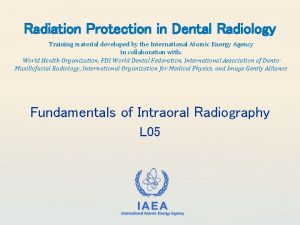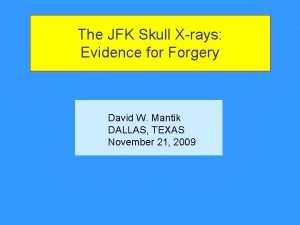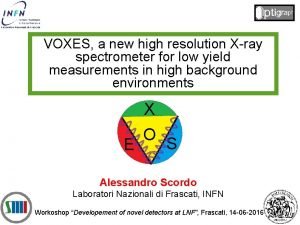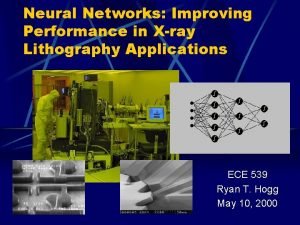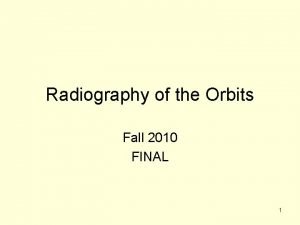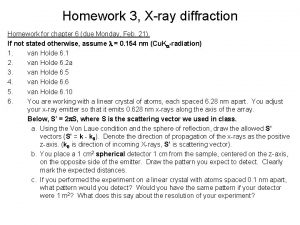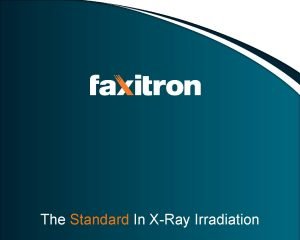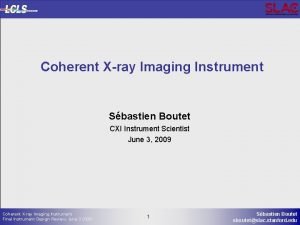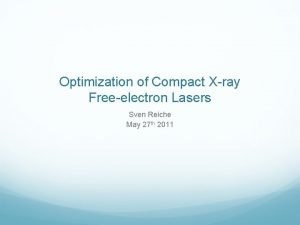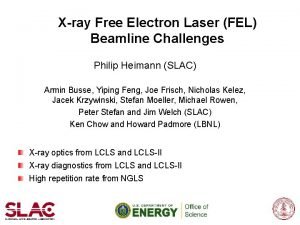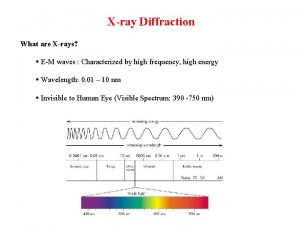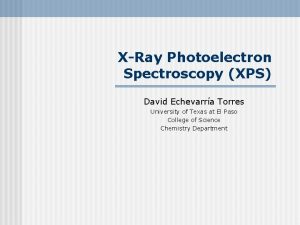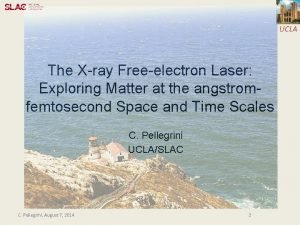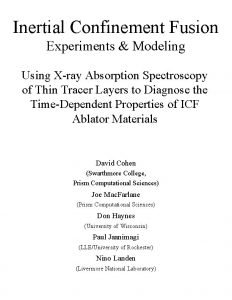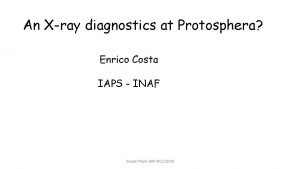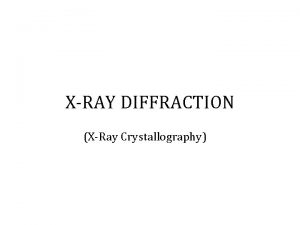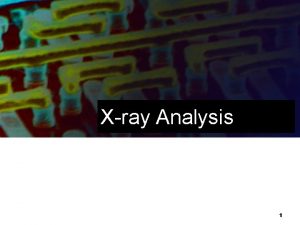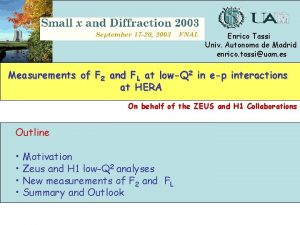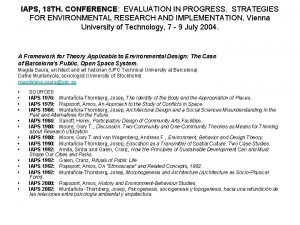XRay Polarimetery ScienceDetecors Enrico Costa IAPS Roma Enrico







































- Slides: 39

X-Ray Polarimetery: Science&Detecors Enrico Costa IAPS Roma Enrico Costa, Paolo Soffitta, Fabio Muleri, Sergio Fabiani, ……. INFN Pisa Ronaldo Bellazzini, Alessandro Brez, Luca Baldini, Gloria Spandre, Massimo Miniuti, Michele Pinchera UNIVERSITY of ROMA-3 Giorgio Matt, Stefano Bianchi Collaboration for the optics OSSERVATORIO ASTRONOMICO DI BRERA Milano Gianpiero Tagliaferri, Giovanni Pareschi, Daniele Spiga X-Ray Polarimetry: Science & Detectors - Beijing 21 -2 -14

Why Polarimetry? Digging in literature Astrophysics Acceleration phenomena: • Pulsar wind nebulae • μQSO • Blazar and radiogalaxy • Solar Flares Emission in magnetic fields: • Emission in strong magnetic fields: magnetic cataclysmic variables • Emission in strong magnetic fields: accreting millisecond pulsars • Emission in very strong magnetic fields: accreting X-ray pulsars Scattering in aspherical situations • X-ray binaries • Radio-quiet AGN • X-ray reflection nebulae Fundamental Physics Matter in Extreme Magnetic Fields: QED effects Matter in Extreme Gravitational Fields: GR effects Quantum Gravity Search for axion-like particles X-Ray Polarimetry: Science & Detectors - Beijing 21 -2 -14

Synchrotron: X-Rays vs other bands Radio Infrared (VLA) (Keck) Optical X-rays (Palomar) (Chandra) In the Crab X-rays are emitted by synchrotron from freshely accelerated electrons in magnetic fields. X-Ray Polarimetry: Science & Detectors Beijing 21 -2 -14

Acceleration phenomena: μQSO The polarization degree of the SSC emission as a function of the Lorentz factor of the electrons θo is the angle between the observer and the magnetic field (from Celotti&Matt, 1994). The study of their time and energy-dependent polarization properties (possibly combined with simultaneous radio and optical polarization measurements) can help shading light on jet formation and evolution, and its relation to accretion disk emission. These studies may also be applicable to AGN (e. g. Mirabel 2007), but in μQSO we have the possibility, thanks to the much smaller time scales, to study their behavior over a wide interval of accretion rates X-Ray Polarimetry: Science & Detectors - Beijing 21 -2 -14

PWN The only polarized source already known Positive measurement: of Xray polarization of the Crab Nebula without pulsar contamination (by lunar occultation, Weisskopf et al. , 1978). P = 19. 2 ± 1. 0 % = 156. 4 o ± 1. 4 o XEUSBut this is only the average measurement structure is much more complex! To p. s. f. The perform separate polarimetry of details of f. o. v. PSR NW jet SE jet Inner torus Outer torus the major structures we need imaging! How turbulent is the field? How polarized is the PSR? At much higher energies INTEGRAL finds polarization oriented as the jet axix. Morover we know from AGILE (confirmed by Fermi) that the Crab (not the PSR) is varying on the scale of days at E>100 Me. V. These corresponds to a physical region on the arcsecond timescale! Tavani et al. 2011 X-Ray Polarimetry: Science & Detectors - Beijing 21 -2 -14

Acceleration phenomena: Blazar and radiogalaxy While the polarization angles of synchrotron and SSC emission are expected to be the same, and perpendicular to the magnetic field (Celotti & Matt 1994), in the external photons model the IC polarization is related to the jet axis (Begelman & Sikora 1987), and the polarization angle in the two peaks needs no longer to be the same. In both models, the polarization degree (see Figure 2) is expected to be very high, up to 50% or more unless the electrons responsible for the IC emission are hot (see also Poutanen 1994). X-Ray Polarimetry: Science & Detectors - Beijing 21 -2 -14

Acceleration: SNR In SNR the high energy tails show a non thermal emission, in the front regions of the shock. This could also be singed out by polarimetry, depending on how mch the magetif fields are ordered. X-Ray Polarimetry: Science & Detectors - Beijing 21 -2 -14

Another case of extended source: reflection nebulae Sgr. B 2 is a giant molecular cloud at 100 pc projected distance from Sgr. A The spectrumof Sgr. B 2 is pure reflection spectrum Reflection of what? No bright enough source is there The emission from Sgr. B 2 is extended and brighter in the direction of Sgr. A, Murakami 2001 Rashid Sunyaev suggested that Sgr. B 2 is reflecting the emission from the Black Hole in Sgr. A as it was a few hundred years ago. Integral Image of GC, Revnivtsev 2004 X-Ray Polarimetry: Science & Detectors Enrico Costa – X-Ray Polarimetry – Tsinghua Global Vision Lectures -– Beijing December 6 2011

When Our Galaxy was an AGN Definitely imaging is needed also in this case X-Ray Polarimetry: Science & Detectors - Beijing 21 -2 -14

Emission in very strong magnetic fields: magnetic NS Spectropolarimetry may constraint the accretion geometry. Electron (in strong B) or proton (in extreme B) cyclotron lines may X-Ray Polarimetry: Science & Enrico Costa – X-Ray Polarimetry – Tsinghua Global Vision Lectures – Beijing December 6 2011 Meszaros et al. (1988) Detectors - Beijing 21 -2 -14

Cyclotron lines with 100 ks of observation with NHXM-MEP The extension of polarimetry to Hard X-Ray can allow for a detailed study of cyclotron lines. All detected lines are above 10 ke. V. Photoelectric polarimetry extended to higher energies (such as in NHXM) or good quality compton polarimetry can allow for a direct exploration of the cyclotron resonances. Here we need the high energy Enrico Costa – X-Ray Polarimetry – Tsinghua Global Vision Lectures – Beijing December 6 2011

The Spin of Black Holes: a 4 th method X-Ray Polarimetry: Science & Detectors - Beijing 21 -2 -14

Fundamental parameters Unpolarized Every polarimeter is composed of an analyzer, a stage where an interaction occurs, whose Polarized outcome angle depends on polarization, and a detector of the products of the interaction, capable to measure their angular distribution. X-Ray Polarimetry: Science & Detectors - Beijing 21 -2 -14

Fundamental parameters Fit function: Modulation: Polarization: = is the modulation factor, i. e. the modulation for 100% polarized radiation X-Ray Polarimetry: Science & Detectors - Beijing 21 -2 -14

Basic Statistics Martin C. Weisskopf, Ronald F. Elsner, Victoria M. Kaspi, Stephen L. O’Dell, George, G. Pavlov, and Brain D. Ramsey: X-Ray Polarimetry and Its Potential Use for Understanding Neutron Stars Minimum Detectable Polarization (99%): If background is negligible: To reach MDP=1% with µ=0. 5: Source detection: Source spectral slope: Source polarimetry: = 736 103 ph >100 ph (for continuum) >100, 000 ph Polarimetry is a matter of number of photons Long observations and/or large area are needed X-Ray Polarimetry: Science & Detectors - Beijing 21 -2 -14

Which Detectors for X-ray Polarimetry Traditionally (35 years ago!) only polarimeters based on Bragg diffraction aroud 45°. A large number of detectors proposed with different energy range and sensitivity. None approved so far. • • Based on: Diffraction/Photoelectrc Effect/Compton Scattering Philosophy: Dispersive / Not Dispersive Strategy: Collimated / Focal Plane Band: Very Soft (<2 ke. V)/ Soft (2 -10 ke. V), /Medium (5 -30 ke. V) / Hard (>20 ke. V); Narrow band / Broad Band X-Ray Polarimetry: Science & Detectors - Beijing 21 -2 -14

Polarimetry by Diffraction at ~ 45° Traditionally (35 years ago!) only polarimeters based on Bragg diffraction aroud 45°. Rocketts, OSO-8 Bragg Diffraction at > 2 ke. V is nowadays overruled by photoelectric polarimeters. At energies < 1 ke. V is still the only viable technique. Due to thre need of rotation and of long dedicated pointing is a typical application for a (very) small dedicated satellite. Lightweight Asymmetry and Magnetism Probe (~250 e. V) (Tsinghua, Tongji, INAF, INFN) Pulsars To measure the geometry of B-field To constrain the equation of state Be able to identify “bare quark stars” �Jets in Blazars To measure the B-field in the X-ray jet �Black hole binaries and AGNs To measure the disk inclination and help constrain BH spin Also H. Marshall at MIT is working on proposals based on bragg diffraction X-Ray Polarimetry: Science & Detectors - Beijing 21 -2 -14

The dominant technique in soft/medium range for focal plane: the Photoelectric Polarimeter X-Ray Polarimetry: Science & Detectors - Beijing 21 -2 -14

The same concept Two different implementations The TPC has: • is more sensitive, at last down to levels where the source exceeds the backround (. 2 m. Crab for GEMS) • Can have an exit window for photons that have not been detected. The GPD has: • Imaging capability (80µm for parallel beam 100µm for a typical X-ray optics) • No need of rotation • Better control of systematics • More margin vs the background • Low power (2 W the GPD; 12 W the BEE) • It is light (GPD+Buffle+Filter Wheel+Mech. IF = 3. 3 kg from IXO study) and since is connected to the BEE with a flexi cable it can be mounted on a sliding device X-Ray Polarimetry: Science & Detectors - Beijing 21 -2 -14

OUR DETECTOR X-Ray Polarimetry: Science & Detectors - Beijing 21 -2 -14

MORE RECENT EVOLUTION For the ESA M 3 proposal New Hard X-ray Mission (a competitor of GRAVITAS) we prototyped a hard X-ray detector based on a thicker absorption gap filled with Argon at higher pressure. We found some irregularities in the electric field that would produce a distrotion of the image and spurious polarization. It was clear (not surprisingly) that to increase thickness of the detector we had to make larger electrodes. So we changed our design: 80 g 300 g X-Ray Polarimetry: Science & Detectors - Beijing 21 -2 -14

GPD spatial resolution – Uniform drift field He 20% – DME 70% 1 bar 1 cm Titanium fluorescence @ 4. 5 ke. V + Brem. 0. 3 mm FWHM 82 mm X-Ray Polarimetry: Science & Detectors Beijing 21 -2 -14

Modulation factor 2. 6 ke. V Energy Modulation factor 2. 6 26. 68 +/- 0. 42 4. 5 42. 75 +/- 0. 24 6. 4 52. 44 +/- 0. 31 X-Ray Polarimetry: Science & Detectors Beijing 21 -2 -14

Spurious modulation and energy resolution 125 kcounts: Modulation factor: ~50% Spurious modulation measured: ~0. 54% Spurious polarization measured: ~1% MDP 99% with m=50% and 125 kc: ~ 2. 3% X-Ray Polarimetry: Science & Detectors Beijing 21 -2 -14

Last attempt: XIPE proposed as ESA SM X-Ray Polarimetry: Science & Detectors - Beijing 21 -2 -14

2 JET-X telescopes One of these telescopes is the optics of Swift XRT. Cannot image better qualification X-Ray Polarimetry: Science & Detectors - Beijing 21 -2 -14

X-Ray Polarimetry: Science & Detectors - Beijing 21 -2 -14

XILPE after XIPE not selected XIPE was submitted at the first AOO for an ESA small mission Good evaluation by ESA from the feasibility and readiness. Weak only from the budget point of view. An ecellent rating by Physics Science Working Group. Rated 2 d by Astrophysics Working Group CHEOPS (exoplanets photometry) was selected In response to the ESA-CAS announcement we propose XILPE: a Ligth (=descooped) version of XIPE. No solar polarimeters. One telescope only. We hope to fit the (very tight) boundaries fixed by the announcement. To define the chinese contribution. A collaboration with Tsinghua University is already active on detectors. Optics could be another area of interest. A. o. b. is on the table. X-Ray Polarimetry: Science & Detectors - Beijing 21 -2 -14

Test at PANTER facility We tested the GPD with one JET-X telescope at Panter Facility of Max Planck in Munich. Results are very encouraging for the imaging. For the search of systematics the statistic is still poor With a CCD the resolution (HPW) is 16 arcseconds. The efficiency is the same it was 10 years ago. With a GPD the resolution (HPW) is 23 arcseconds. Exactly what expected from the space resolution and the blurring due to the inclined penetration in the detector. But it is measured not simulated!. X-Ray Polarimetry: Science & Detectors - Beijing 21 -2 -14

The telescope performs as predicted With a GPD the resolution (HPW) is 23 arcseconds. Exactly what expected from the space resolution and the blurring due to the inclined penetration in the detector. But it is measured not simulated!. X-Ray Polarimetry: Science & Detectors - Beijing 21 -2 -14

Off-axis performance X-Ray Polarimetry: Science & Detectors - Beijing 21 -2 -14

Do we really need imaging? Extended Sources Supernova Remnants (SNRs) are believed to be the acceleration sites of cosmic rays up to 1015 e. V. While the line emission makes it possible to determine the state of ionization of its thermal plasma, the lack, or the weakness, of emission lines is generally believed to be due to acceleration mechanisms responsible for the synchrotron emission or non thermal Bremsstrahlung. Moreover, Te. V emission from some SNRs supports the idea that in some regions, electrons are energized at least up to Te. V. Imaging polarimetry in this regard is useful to localize the regions of shock acceleration and to measure the strength and the orientation of the magnetic field at these emission sites (Vink (2012)). Probing the regions where thermal or nonthermal plasma is emitting in X-rays is particularly important in SNRs like Cas A or Tycho (see e. g. Araya and Cui(2010). Pulsar Wind Nebulae Spatially resolved X-ray polarimetry allows the magnetic field orientation in the torus, in the jet and at various distances from the pulsarto be determined. This makes it possible to evaluate the level of turbulence and instabilities exploring the acceleration mechanism responsible for the observed particle distribution (Shibata et al (2003); Volpi et al (2009)). XIPE reaches an MDP of 2% in 5 × 5 angularly resolved regions of the Crab Nebula in 105 s of observing time thanks to its imaging capability. The capability to resolve the surrounding nebula makes the emission model to be derived and compared for example with those studied in optical band (Harding (2005)). A few additional PWNs will be accessible to XIPE for comparative measurements (see fig. 1). More extended sources are Galaxy Clusters that should be unpolarized by definition. Beside the search for nonthermal component present in a few (such as A 2256), they could be a good screen to search for polarization introduced by photon-axion conversion (Bassan, Mirizzi, Roncadelli 2010) in intergalactic magnetic fields. X-Ray Polarimetry: Science & Detectors - Beijing 21 -2 -14

Angular resolved polarimetry of Crab We simulated a long observation of Crab with XIPE. We blurred the Chandra image to account for the limited resolution of XIPE. The major features are still visible. We computed the sensitivity to the amount and angle of polarization for different selected regions of the nebula. Fabiani et al. Ap. J under review. X-Ray Polarimetry: Science & Detectors - Beijing 21 -2 -14

Angular resolved polarimetry of CAS-A X-Ray Polarimetry: Science & Detectors - Beijing 21 -2 -14

With the equation of sensitivity we can scale from XIPE to XILPE X-Ray Polarimetry: Science & Detectors - Beijing 21 -2 -14

A medium energy polarimeter for multilayer optics? We built a first prototype of the so-called Medium Energy Polarimeter (MEP). As mentioned before the first attempt by only increasing the thickness and pressure failed because of irregulariries in the electric field. A second attempt was performed with the new design of detector. The new prototype was well performing from the point of view of uniformity, and of the energy resolution but in a few weeks showed a decay of the spectral performances, evidence of a leak. Notwithstanding we could still measure a modulation in response to a polarized beam not far from that predicted. We are confident that by repearing the detector it will work nominally. Moreover the Monte Carlo simulations are usually more reliable at higher energies. Photoelectrons from 22 ke. V photons The MEP with 3 cm absorption/drift gap and 3 Atm pressure of Ar/DME mixture should be very effective from 5 to 30 ke. V. X-Ray Polarimetry: Science & Detectors - Beijing 21 -2 -14

A high energy focal plane polarimeter Fabiani et al. Ex. A 2013 X-Ray Polarimetry: Science & Detectors - Beijing 21 -2 -14

Three polarimeters for different energies The High Energy Polarimeter is more tuned to multilayer optics with long focallength (8 -10 m). The other two polarimeters can be suited for XTP. X-Ray Polarimetry: Science & Detectors - Beijing 21 -2 -14

How can we contribute to XTP? An Xray optics 2 -10 ke. V would improve the XIPE performance (MDP) as the √ of the Area. With a focal of 4 m the angular resolution would be dominated by the telescope for HPW>30 arcseconds. XTP area should be around 20 times XILPE area The 2 available JET X telecopes with a LEP in the focus could be added to XTP. The mass resource needed is aroiund 200 kg. If readiness is important whatever already exists is specially wellcome. We could also study the possibility to substitute the baseline window of Be with a thin window so that the detectors would provide an extension down to. 15 ke. V (images and spectra only not polarimetry below 1. 5 ke. V) MEP detectors could fit the focalplane of M/L telescopes. Of course the competitivity of imaging requires an adequate resolution of the optics. X-Ray Polarimetry: Science & Detectors - Beijing 21 -2 -14
 Kontextusfüggő emlékezet
Kontextusfüggő emlékezet Iaps
Iaps Emulsion peel in radiography
Emulsion peel in radiography Pancreatic calcification
Pancreatic calcification Pulmonary embolus
Pulmonary embolus Jfk x ray
Jfk x ray Xray training
Xray training Tetralogy of fallot xray
Tetralogy of fallot xray Michigan xray
Michigan xray Gladstone park xray
Gladstone park xray Silicon valley xray
Silicon valley xray Bga xray
Bga xray Xray spectrometer
Xray spectrometer Xray lithography
Xray lithography Rheese orbits positioning
Rheese orbits positioning Homework
Homework Xray file cabinet
Xray file cabinet Kub xray
Kub xray Xray lara
Xray lara Rds case study
Rds case study Pneumobilia adalah
Pneumobilia adalah Picker xray
Picker xray Xray laser
Xray laser First xray ever taken
First xray ever taken Pink tof vs blue tof
Pink tof vs blue tof Xray laser
Xray laser Xray waves examples
Xray waves examples Gegasx
Gegasx Mmc xray
Mmc xray Fadhl alakwaa
Fadhl alakwaa Xps instrument
Xps instrument Facial bone xray
Facial bone xray Crista gali
Crista gali Xray laser
Xray laser Inertial confinement fusion lasers
Inertial confinement fusion lasers Xray xml editor
Xray xml editor Unipolar generator
Unipolar generator Gimp xray
Gimp xray Capacitor-discharge mobile x-ray units
Capacitor-discharge mobile x-ray units Subject contrast
Subject contrast


